Today we’re going to show you how to use API integration with routing software.
Specifically, how to plug eLogii into any:
Business system
Software suite
Or third-party app
That you’re using for your delivery operations.
So you can get access to more functionality in and out of our system.
Let’s dive right in.
What Is a Routing API?
API refers to Application Programming Interface. In routing, the word Application refers to the route planning software and any other software that has a specific function. While the Interface defines how the two programs communicate and share data with one another using determined requests and responses.

Why Is API Integration Important?
APIs are basically channels different apps use to communicate with each other.
Each of these channels enables the apps to say to each other:
“You can use this function.”, or “Add this data automatically to your platform.”
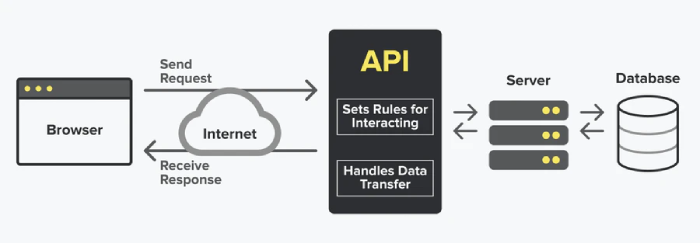
So the more apps you use to manage operations, the more you need to integrate them.
To make it faster and easier to complete multiple tasks on one platform.
Rather than having to switch between multiple apps.
For example, if you’re using a telematics system like Samsara, you’ll want to integrate it with eLogii.
So that you can track and monitor vehicles in real-time while they’re delivering goods to your customers.
So does API Integration make a difference in 2022?
Absolutely!
Why?
It enables process automation by combining planning, dispatch, execution, and post-execution tasks all in one place.
And how you perform all of those activities as part of your overall business strategy.
In fact, Gartner’s top strategic technology trends for 2022 states that:
Hyperautomation is a disciplined, business-driven approach to rapidly identify, vet and automate as many business and IT processes as possible.
Hyperautomation enables scalability, remote operation and business model disruption.
That said:
There’s more to route optimization APIs than just automation.
Which leads us to…
How Does API Integration Work with Routing Software?
Routing APIs generally do two things:
1. APIs set rules for how apps interact with routing software.
In other words: a routing API structures requests in and out of the system. You’re basically telling the software what you want it to do in a way that the system understands your request.
2. APIs handle data transfers between the server and the code that’s making a request.
In simpler terms: The API acts as a middleman between the route optimization software and the server and database. While connecting it to the second application.
Once the route optimization API receives a valid request, it runs a function (or multiple functions) for you.
Depending on your request, it will return with a confirmation.
That lets you know that it has successfully received the request.
And/or completed the action.
With that, let’s show you what actions you can perform.
What Can You Integrate with eLogii?
eLogii is a SaaS delivery management platform.
It’s a software as a service.
So it’s organized around REST APIs.
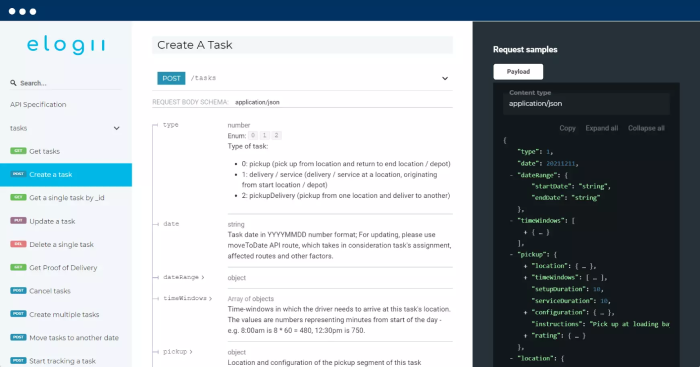
It follows standard practices such as predictable, resource-based URLs.
And all requests are accepted over SSL and encoded as JSON.
In its simplest form, REST APIs follow this path:
- Your web-based application (API-enabled routing software)
- Remote server
- Data request
- Returned data/function
Generally, REST APIs are reserved for web-based services and applications.
In fact, 70% of public APIs are REST APIs.
That’s because they provide greater flexibility.
And they also work directly from a HTTP URL rather than relying on XML.
All of this means that you can integrate eLogii with pretty much any software solution, including:
Order Management Systems (OMS)
- QuickBooks Commerce
- Brightpearl
- Veeqo
- Adobe Commerce (Magento)
- Salesorder
- Orderhive
- Skubana
- LinnWorks
- And more
Ecommerce Platforms
- Shopify
- BigCommerce
- WooCommerce
- Squarespace
- Magento
- Shift4Shop
- Zyro
- And more
Warehouse Management Systems (WMS)
- Sortly
- NetSuite WMS
- Fishbowl Inventory
- 3PL Warehouse Manager
- Geneva Systems
- Infor SCM
- HighJump
- TECSYS WMS
- And more
Telematics Systems
- Keeptruckin
- Samsara
- AMS (Asset Monitoring Solutions)
- Trimble TMS
- Switchboard
- Webfleet
- Fleetio
- Verizon Connect
- And more
Enterprise Resource Planning (ERP) Systems
- NetSuite
- SAP Business One
- Sage Intacct
- Acumatica
- SAP Business
- TallyPrime
- Oracle PeopleSoft
- And more
Customer Relationship Management (CRM) Software
- Zoho
- Hubspot
- Freshsales
- Zendesk
- Salesforce
- Insightly
- Pipedrive
- And more
eLogii's Webhooks
What makes eLogii stand out from the rest is that you can use 2-way integration thanks to webhooks.
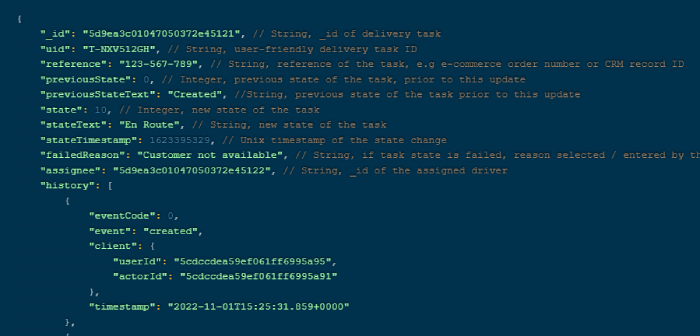
eLogii’s webhooks include:
Task Lifecycle Update: This webhook is triggered when an update to a delivery task happens. For example, the task is in progress. Or the task has been completed.
Task or Driver Tracking: Driver or order location while a specific task is in progress. It enables you to track drivers or orders from the moment a task is activated until it is completed.
Optimization Complete: This is triggered whenever the software performs an optimization request. And it lets you retrieve a list of routes and used drivers for those routes by the software.
Route ETAs Update: It gives you access to the estimated time of arrival for tasks on a specific route.
Route Created: Informs you whenever a new route is created on the platform.
Route Updated: This is triggered when you re-adjust the route on the platform. Or if the driver takes a different route while on the road.
Route Completed: Informs you when all tasks on a specific route have been completed.
Route Removed: Lets you know when a specific route has been removed from the platform.
How to Integrate Your Apps with eLogii [Step-By-Step]
To be clear:
API Integration with any software is technical. A LOT!
So we suggest that you have a developer on call.
And we absolutely suggest that you contact our support team at support@elogii.com.
Better yet, you can book a demo. And our team can explain it to you live and in depth.
Still, the process is fairly straightforward:
First, you or your tech staff should download the API documentation.

There you’ll have all the information you need to integrate eLogii with other apps.
Specifically:
eLogii API uses an API key in combination with the Authorization header.
This is the method to authenticate the software.
And connect it to our route optimization platform.
To do this, you’ll have to go to the eLogii dashboard.
Go to the menu.
And select API keys page.
Here you can generate an API Key:
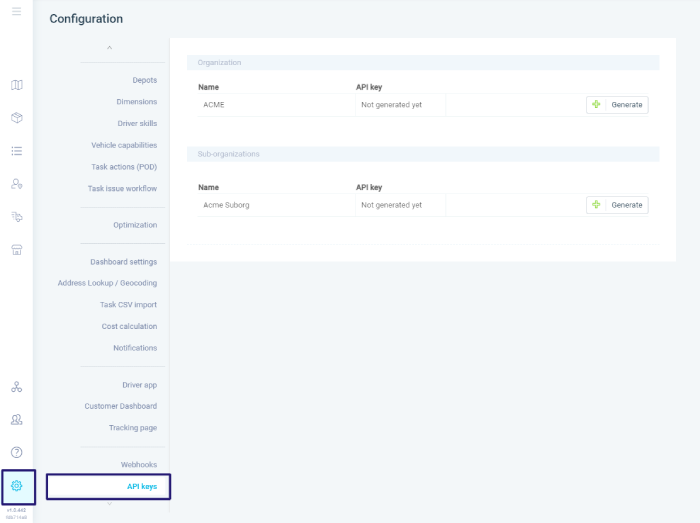
Once you have the key you should then add it to the authorization header:

And once the key is authenticated, the integration is complete.
And you can start using eLogii with your third-party apps.

Benefits of Routing API Integration
1. Automation
API integration enables the handoff of data and information from route optimization software to other third-party applications automatically.
That eliminates the need for manual (human) intervention.
Which saves you time.
For example, there’s no need for dispatch to locate drivers by calling them.
Instead, they can access a monitoring screen and view the real-time location of each driver on the map.

And significantly reduces errors at any point in the delivery lifecycle.
For example, delivery planners don’t have to input order information by hand.
Rather, the software can do it automatically for them from your order management system.
2. Scalability
API integration allows your business and delivery operations to grow at scale.
Specifically:
You don’t need to start from scratch to create an integrated system of apps.
Maybe, you want to start using a warehouse management system (WMS).
All you have to do is set up a new API to integrate it with your route planning software.
So each time you start using a new app you simply add it to your existing stack via APIs.
3. Streamlined Visibility
API integration provides you with end-to-end visibility of all systems and processes.
Which allows you to generate reports and track and review data more effectively.
For example, you can integrate your last-mile delivery software with an OMS and WMS.
Since you get reports from all three systems, you’ll have a better handle over your supply chain.
And in this case, you’ll be able to better manage your supplies.
You’ll know whether you’ll need to order more goods from your supplier.
And to which warehouse to dispatch drivers to pick up specific orders to fulfill them.
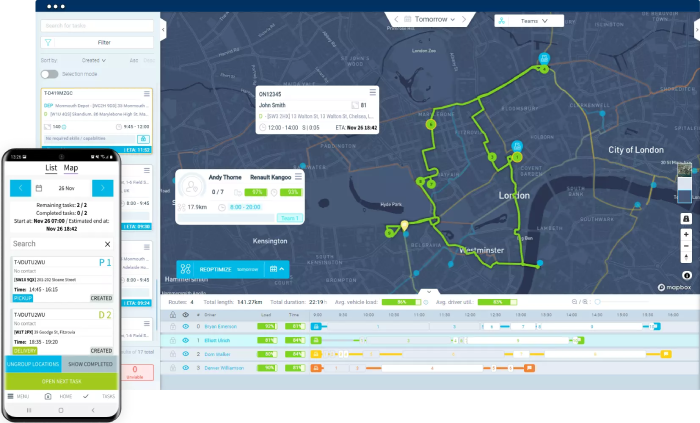
Bottom Line: Why Start Using Routing APIs
The bottom line is clear.
APIs enable you to plug into any system, software, or app that you use.
And that facilitates the automation of your business.
That in turn:
Centralizes how you manage operations.
Raises operational speed and efficiency.
Boosts accuracy by reducing human error.
Saves you time and cuts operational costs.
But that’s not all eLogii can help you with.
To learn more about how eLogii can automate your daily operations: